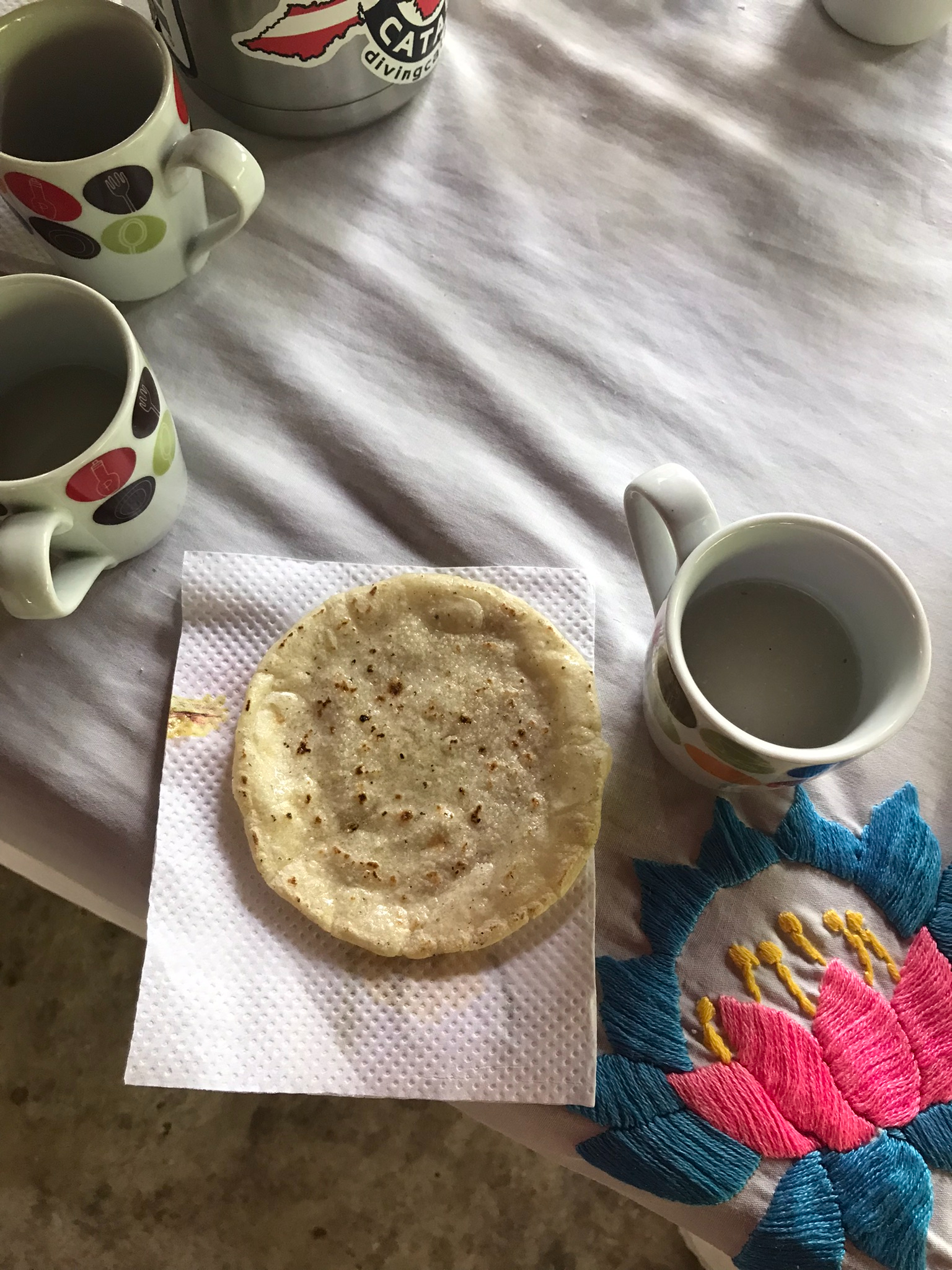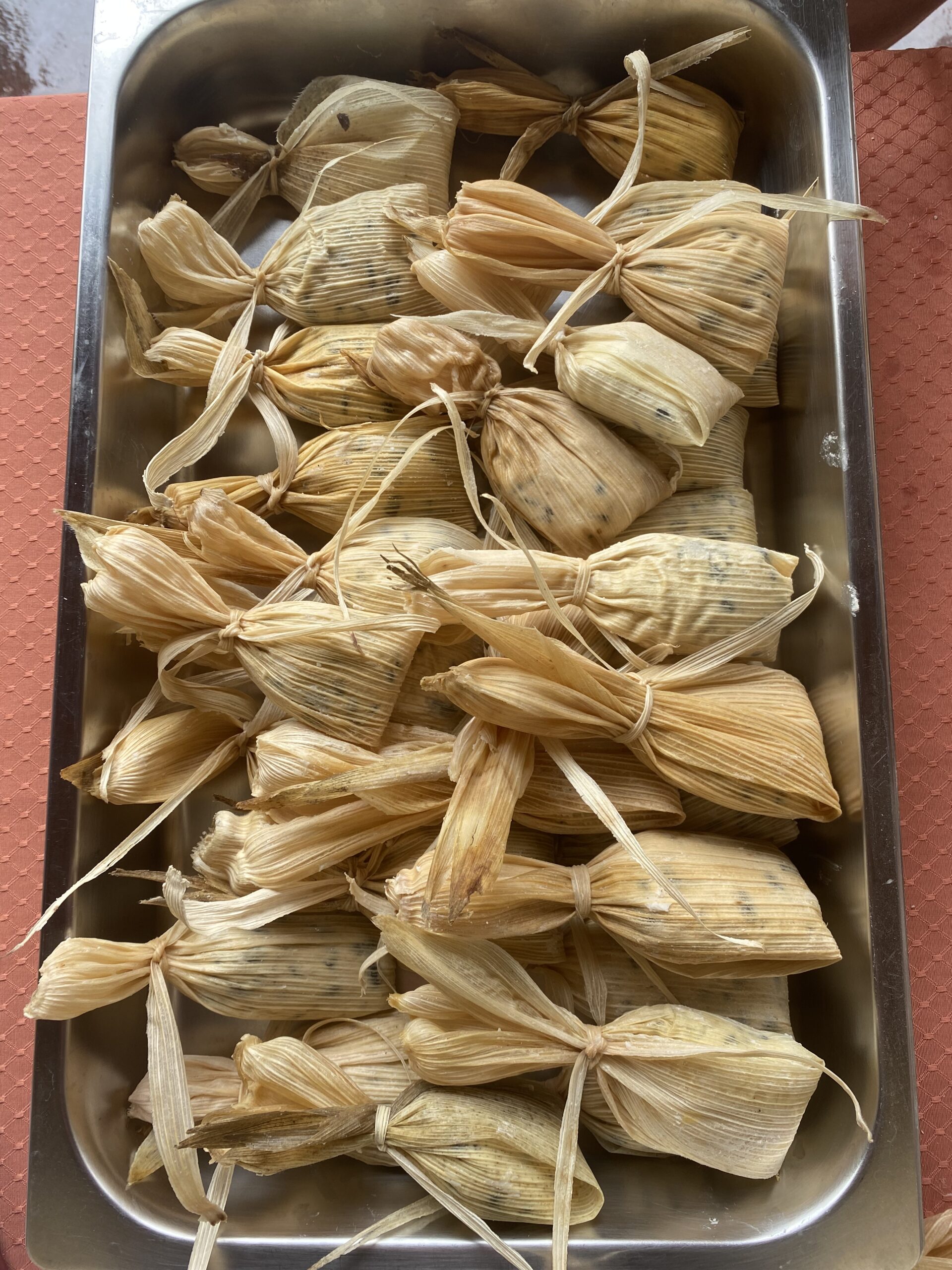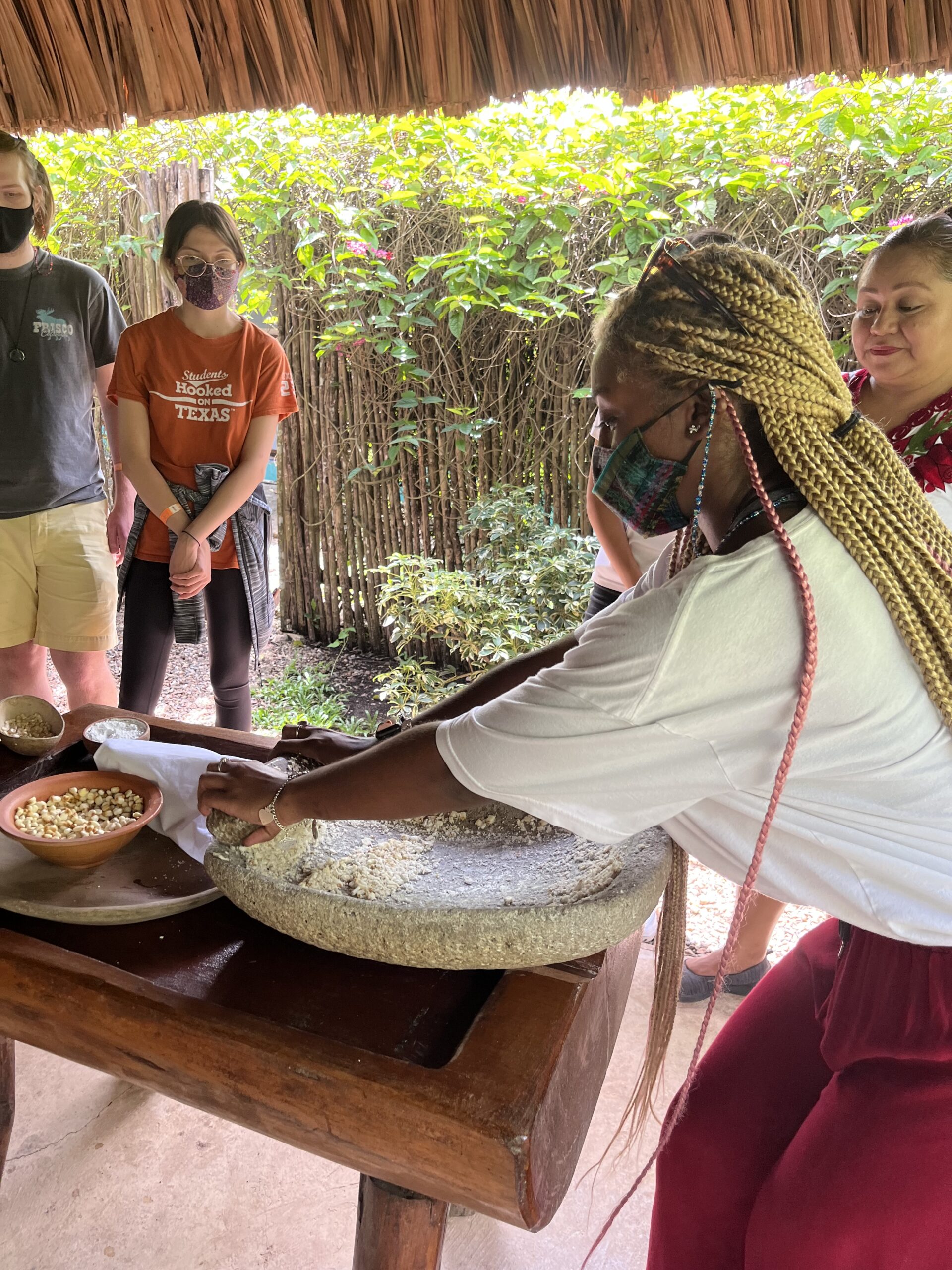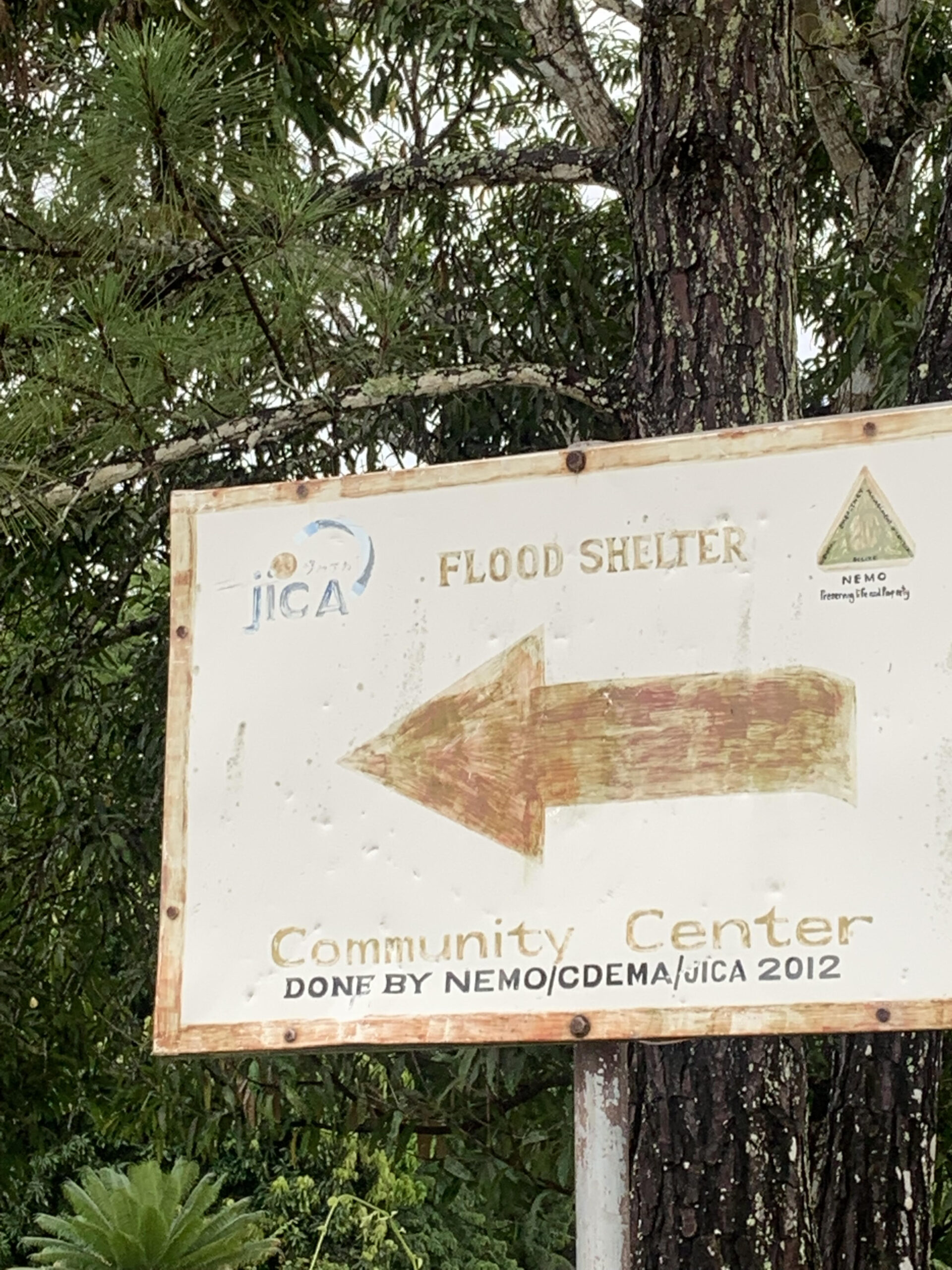1. Welcome Dinner!
A few hours after we arrived in Antigua, our group was treated to an exquisite welcome dinner at Casa Herrera, a 17th-century colonial building that today serves as a UT’s Mesoamerica teaching and research center. The main course was a hearty serving of a traditional thick stew (typically known as pepián which is thickened with gourd seeds and cooked with tomatoes and peppers. This stew was accompanied by a side of rice and a tamale. For dessert, we enjoyed a version of rellenitos de plátano, stuffed plantains (traditionally filled with beans) topped with sugar and cinnamon, along with coffee served in clay mugs. It was the perfect way to get to know each other and relax after travel.

Group photo in the Casa Herrera hall taken by our professor Dr. Astrid Runggaldier

My bowl of delicious vegetarian-friendly pepián

A stuffed plantain treat for dessert
2. An Uphill Journey
One morning early in the program, my classmates and I decided to hike up to Cerro de la Cruz (Hill of the Cross). With an elevation of over 200 feet, this spot boasts a breathtaking view of much of the city of Antigua as well as of the stratovolcano named Volcan Agua. The hike was not easy, taking about 20 minutes to the outlook featuring a massive cross, but it was well worth the effort. It was a great group bonding experience and set the tone for the many journeys to come.

Taking in the fresh air and spreading my wings by the Cerro de la Cruz overlook
3. Maya Culture and Coffee
One of our first group excursions was to a town just north of Antigua known as Jocotenango. There, we visited Casa K’ojom, a cultural center and museum named after the K’iche’ Maya word for a type of marimba, now the national instrument of Guatemala.

Recreation of a traditional Maya marimba instrument and musicians

Samuel locates the town of Jocotenango on a map of Guatemala’s Sacatepéquez Department

A recreation of a traditional Maya market with women selling fruits, vegetables, and sugarcane
Later, we explored the coffee farm, Finca La Azotea, with our tour guide, Manuel. Coffee grown in the volcanic soil of the Guatemalan highlands where the farm is situated tends to be better quality than that grown in the lowlands. Antigua is home to a delicious medium-dark roast. Roasting coffee beans is a long and intensive process including fermenting, the need for people to turn water every 2 hours while washing and drying. Organically grown coffee is best for human, animal, and environmental health.

Manuel points out an avocado tree, which provides shade for coffee under which it grows best, along with providing food for animals
4. All about Textiles
As part of a two-day trip to the towns surrounding Lake Atitlan, we learned about the growing, dying, and processing of cotton by the women at the textile cooperative in San Juan La Laguna. The labor is very intensive and requires great physical exertion. Our tour guide, Ana, demonstrated the cotton spinning process, which takes 15-16 hours to produce one ball of cotton, that is then dipped in natural dyes. Ana also showed us the process of weaving the cotton on a traditional backstrap loom, explaining that it often takes several hours and multiple days to produce various goods. I enjoyed supporting the co-op through the purchase of affordable gifts that my friends and family would enjoy.

Ana demonstrates the cotton spinning process in a room of the shop that features a photo of co-op founder Teresa Ujpan Pérez in the background

Ana demonstrates the traditional Maya art of weaving on a backstrap loom
5. Chocolate Tour and Tasting
During our final week in Antigua, we took a field trip to Chocolate Antigua in the pueblo of San Juan del Obispo. Cacao is a very important part of Maya culture, once serving as currency, and kings would drink chocolate from large vases as an ostentatious display of wealth. Spanish colonization and trade contributed to the dispersal of the delightful treat available around the world (for better or for worse). Chocolate Antigua boasts delicious and affordable creations ranging from chocolate “wheels “to hot chocolate to chocolate tea. We had the opportunity to try some of the delicious spiced hot chocolate served in clay mugs served by our tour guide, Claudia.

My classmates sampling delicious hot chocolate

An extensive selection of dark chocolate on display with flavors ranging from ginger to vanilla to macadamia
6. Cooking Class at Casa Herrera
Chef with Josué López, owner of catering business in Antigua and one of the chefs who made our welcome dinner shared a gastronomy lesson and tamale cooking class. Chef López taught us much about the importance of maize to Maya culture, with a connection to the prominent Maize God and the creation story of the Maya people (called “people of the corn”) detailed in the sacred text the Popul Vuh. We then tried our hand at making our own tamales!

Chef Josué demonstrates the art of making tamales
7. The Great Tikal Hike
After leaving Antigua, we took a trip to Tikal National Park in Guatemala’s Petén department. Our tour guides Noel and Benedicto were very friendly and provided useful information surrounding agriculture in the region and the Maya Biosphere Reserve where the park is located. The Maya Biosphere Reserve contains 2.5 million hectares of vegetation and is home to fascinating creatures ranging from spider monkeys to toucans to jaguars. A highlight of the trip was climbing the great pyramids, especially Temple IV that stands over 200 feet tall and was featured in a Star Wars movie. Afterwards, we enjoyed kebabs for lunch at Restaurant “El Mesón”.

Group photo on top of Temple IV

My veggie kebab plate
8. Belize Maya Co-op
While in Belize, we visited the San Antonio Village Co-op in the town of San Ignacio, which has a predominantly Maya population. The garden surrounding the co-op was stunningly beautiful, providing vegetables and herbs for the meals that we ate during our visit. We learned a lot of interesting facts about San Antonio Village from our hosts: Sarita, Timothemesh, and 15-year-old Alice who recently began work at the co-op. Alice informed us that the San Antonio Women’s cooperative began in 2001 with 3 main goals: 1) Local, fresh, and healthy food and products; 2) Embroidery made by women, selling work for independence; 3) Reviving the art of pottery in the traditional way, using raw materials.

The lovely gardens at San Antonio Village Co-op

Our hosts demonstrating how to grind corn using a traditional mano and metate
We gathered under an outdoor structure with plastered floors and a roof made of palm leaves to make our own tortillas to cook on a clay griddle positioned over a fire hearth. We then had the opportunity to shape and cook our own delicious Yucatec tamales after helping to ground the corn for a masa filling on a 500-year old heirloom: a large, rounded basalt stone known as a mano on a granite metate. We ate these with a corn- and masa-based drink known as atol de elote before learning to make traditional pottery with craftsman Raphael. We then had a hearty and delicious meal of stuffed tamales, mashed yam, salad, and drank cold jamaica (hibiscus tea) provided by our generous hosts. Later, some of us tried our hand at pottery-making with the guidance of expert craftsman Raphael.

With the help of three others I finally got to eat a perfect, warm corn tortilla (best I’ve ever had!) spread with coconut oil and served with a cup of delicious atol de elote.

Raphael shows my classmate Natalie how to handle a particularly difficult step in the traditional pottery-making process

My delicious (and very filling) lunch on an embroidered cloth created by the women at the co-op
9. Farewell at Koko King Beach
On our last day as a group was spent the evening at Koko King Northside Beach Club in Caye Caulker off the coast of mainland Belize. We spent time taking pictures together in the white sand of the beach and some of us went tubing while we waited on our buffet dinner. It was the perfect way to end an eventful and meaningful trip to Central America. A big thank you to my classmates, instructors, and the locals for contributing to Maymester experience! Also, I am truly grateful to Ruta Maya for helping to sponsor my study abroad!

My friend Deanna and me on the beach

Birthday girl Valerie was surprised with a sweet treat!
-Shaina Kambo
































